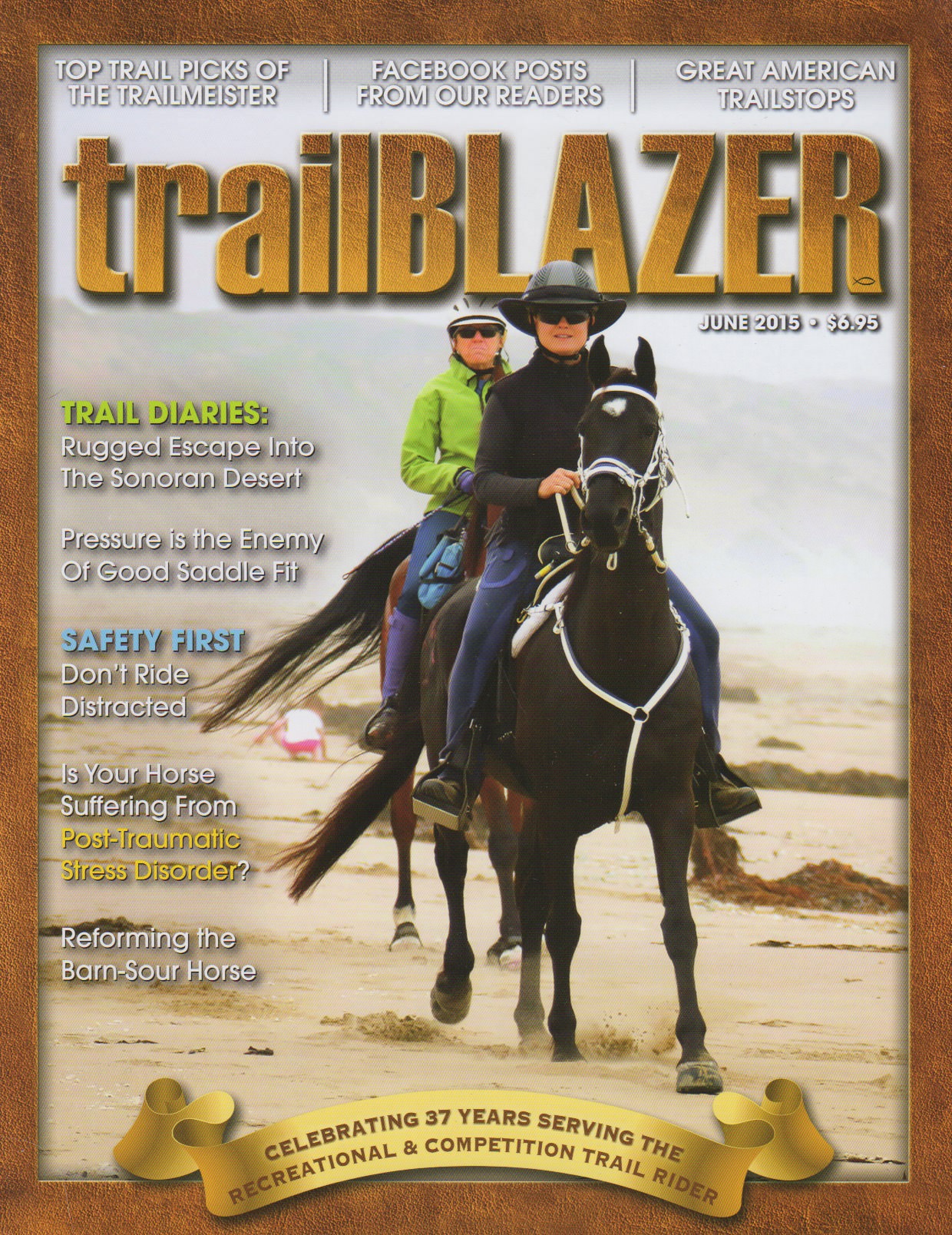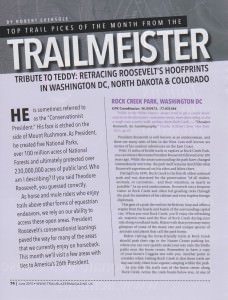 A Tribute to Teddy – Retracing Roosevelt’s Hoofprints in Washington DC, North Dakota & Colorado
A Tribute to Teddy – Retracing Roosevelt’s Hoofprints in Washington DC, North Dakota & Colorado
As Published in TrailBlazer Magazine, June 2015
He is sometimes referred to as the “Conservationist President”. His face is etched on the side of Mount Rushmore. As President he created five National Parks, over 100 million acres of National Forests, and ultimately protected over 230,000,000 acres of public land. Who am I describing? If you said Theodore Roosevelt you guessed correctly.
As horse and mule riders who enjoy trails above other forms of equestrian endeavors we rely on our ability to access these open areas. President Roosevelt’s conservationist leanings paved the way for many of the areas that we currently enjoy on horseback. This month we’ll visit a few areas with ties to America’s 26th President.
 Rock Creek Park, Washington DC
Rock Creek Park, Washington DC
Trailhead Coordinates: 38.959173, -77.051384
“While in the White House I always tried to get a couple hours’ exercise in the afternoons – sometimes tennis, more often riding, or else a rough cross-country walk, perhaps down Rock Creek… – Roosevelt, Theodore. An Autobiography. Charles Scribner’s Sons: New York. 1913. pp 45.
President Roosevelt is well known as an outdoorsman and there are many tales of him in the West. Less well known are stories of his outdoor adventures on the east coast.
With 13 miles of bridle trails to explore at Rock Creek Park you can retrace the routes that President Roosevelt followed over a hundred years ago. While the areas surrounding the park have changed tremendously over time the park itself remains much like what Roosevelt experienced on his rides and hikes here.
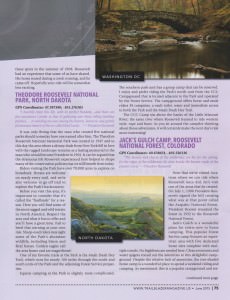 Rock Creek is the fourth oldest national park and dates from 1890 and was chartered for the preservation “of all timber, animals, or curiosities… and their retention, as nearly as possible.” As an avid outdoorsman Roosevelt was a frequent visitor to Rock Creek and often lead grueling treks through the park for members of his cabinet and even hapless foreign diplomats.
Rock Creek is the fourth oldest national park and dates from 1890 and was chartered for the preservation “of all timber, animals, or curiosities… and their retention, as nearly as possible.” As an avid outdoorsman Roosevelt was a frequent visitor to Rock Creek and often lead grueling treks through the park for members of his cabinet and even hapless foreign diplomats.
This gem of a park lies within the beltway loop and offers a respite from the hustle and bustle of the surrounding capitol city. When you visit Rock Creek you’ll enjoy the refreshing fresh air, majestic trees, and the flow of Rock Creek during your ride along the woodland trails. Riders with sharp eyes may enjoy glimpses of some of the many rare and unique species of animals and plants that call the park home.
Riders visiting the horse friendly trails at Rock Creek should park their rigs in the Nature Center parking lot where you can very quickly make your way onto the bridle paths near the horse center. Remember to have a copy of your Coggins test papers with you. Another point to consider when visiting Rock Creek is that these trails are day use only and there is no equine camping within the park.
As you ride the trails east of the horse center, along Rock Creek, notice the creek banks below you. At one of these spots in the summer of 1908 Roosevelt had an experience that some of us have shared. His horse reared during a creek crossing and he came off. Hopefully your ride will be somewhat less exciting.
 Theodore Roosevelt National Park, North Dakota
Theodore Roosevelt National Park, North Dakota
Trailhead Coordinates: 47.587380, -103.276303
“I heartily enjoy this life, with its perfect freedom,…and there are few sensations I prefer to that of galloping over these rolling limitless prairies ,.. or winding my way among the barren, fantastic and grimly picturesque deserts of the so-called Bad Lands…” Theodore Roosevelt
It was only fitting that the man who created five national parks should someday have one named after him. The Theodore Roosevelt National Memorial Park was created in 1947 and to this day the area where a skinny dude from New York fell in love with the rugged landscape, remains as a lasting memorial to the man who would become President in 1901. It can be argued that the strenuous life that Roosevelt experienced here helped to shape many of the conservation policies that we still benefit from today.
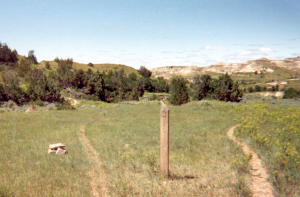 Riders visiting the Park have over seventy thousand acres to explore on horseback. Horses are welcome on nearly every trail and we’re also welcome to go off trail to explore the Park’s backcountry.
Riders visiting the Park have over seventy thousand acres to explore on horseback. Horses are welcome on nearly every trail and we’re also welcome to go off trail to explore the Park’s backcountry.
Before you visit this area it’s important to consider that it’s called the “badlands” for a reason. It’s some of the most rugged and wild terrain in North America. Respect the area and what it has to offer and you’ll have a great time. Fail to head that warning at your own risk. Sharp eyed riders may sight some of the Park’s abundant wildlife including bison and feral horses. Golden Eagles call the area home and are magnificent!
One of my favorite trails at the Park is the Maah Daah Hey Trail, which runs for nearly a hundred miles through the north and south units of the Park and the adjoining Forest Service properties.
Equine camping at the Park is slightly more complicated. The southern park unit has a group camp that can be reserved. I enjoy and prefer riding the Park’s north unit from the CCC Campground that is located adjacent to the Park and is operated by the Forest Service. The campground offers horse and mule riders 38 campsites, a vault toilet, water and immediate access to both the Park and the Maah Daah Hey Trail.
The CCC Camp sits above the banks of the Little Missouri River; the same river where Roosevelt learned to ride western style, rope and hunt. As you sit around the campfire thinking about those adventures will certainly make the next day’s ride more interesting!
 Jack’s Gulch Camp, Roosevelt National Forest, Colorado
Jack’s Gulch Camp, Roosevelt National Forest, Colorado
Trailhead Coordinates: 40.638651, -105.526136
“The beauty and charm of the wilderness are his for the asking, for the edges of the wilderness lie close beside the beaten roads of the present travel.” Theodore Roosevelt
Now that we’ve visited locations where we can ride where Roosevelt once did let’s visit one of the areas that he created. On July 1st, 1908 President Roosevelt signed the bill creating what was at that point called the Arapaho National Forest. President Hoover renamed the forest in 1932 to the Roosevelt National Forest.
 Jack’s Gulch is a wonderful place for riders new to horse camping. This popular Forest Service camp features an equestrian area with five dedicated horse sites complete with multiple corrals. No highlines needed here. Clean restrooms and water spigots round out the amenities at this delightful campground. Despite the relative lack of amenities the tree shaded horse camp is a wonderful place to spend a weekend riding and camping. As I mentioned this a popular campground and reservations are recommended.
Jack’s Gulch is a wonderful place for riders new to horse camping. This popular Forest Service camp features an equestrian area with five dedicated horse sites complete with multiple corrals. No highlines needed here. Clean restrooms and water spigots round out the amenities at this delightful campground. Despite the relative lack of amenities the tree shaded horse camp is a wonderful place to spend a weekend riding and camping. As I mentioned this a popular campground and reservations are recommended.
Riders will enjoy how close Jack’s Gulch is to the Comanche Peak Wilderness area that sits only a half-mile away. The Comanche Wilderness’s 66 thousand acres are home to many miles of excellent equine friendly trails that wind across wildflower filled meadows, along bubbling streams, and through forests of aspen and pine.
Many of the well-signed and maintained trails heading out from the camp are due to the hard work of local volunteer groups. Two of the trails that are the easiest to find from the camp are the Little Beaver Creek and Fish Creek Trails. Both connect other trails letting you ride for as long and as far as you wish. Horses are not allowed within the main group campground area so please be mindful and ensure that horse use stays a part of this remarkable area.
“It was like lying in a great solemn cathedral, far vaster and more beautiful than any built by the hand of man.” Theodore Roosevelt, after camping in Yosemite National Park
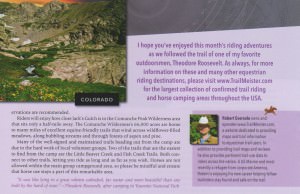 I hope that you’ve enjoyed this month’s horse riding adventures as we followed the trail of one of my favorite outdoorsmen; Theodore Roosevelt.
I hope that you’ve enjoyed this month’s horse riding adventures as we followed the trail of one of my favorite outdoorsmen; Theodore Roosevelt.
As always, for more information on these and many other equestrian riding destinations, please visit www.TrailMeister.com for the largest collection of confirmed trail riding and horse camping areas throughout the U.S.A.


